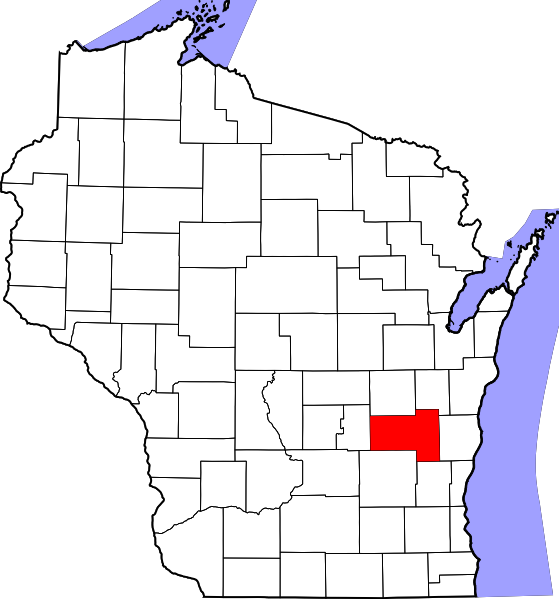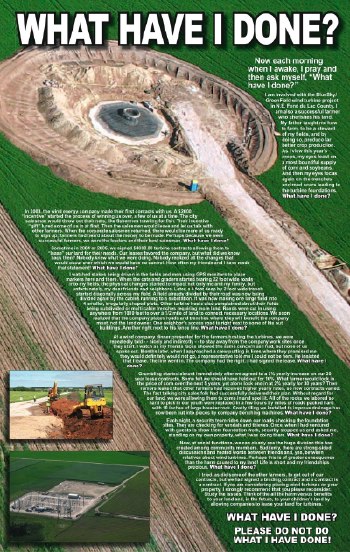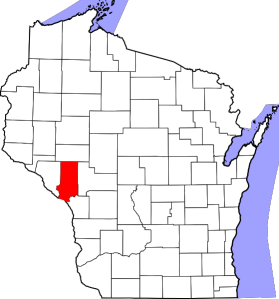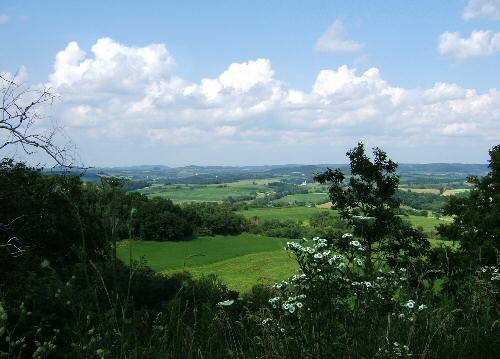1/2/07 What's the Latest From Calumet County?
An article in the January 1st 2008 edition of the Sheboygan Press called "Community Conversations: Wind Turbulence sweeps through Calument County" asks:
"What constitutes protection of public health and safety for siting and operating 400-foot industrial wind turbines with capacities of 1.65 to 2 megawatts?"
For the last year, this question has caused controversy and stress in Calument County and trouble between neighbors that we hope to avoid in our community as we face a similar large wind farm proposal from the same developers.
The article says that among the common health and safety concerns were "unacceptable noise levels that disrupted sleeping and other activities, shadowing and flickering inside residences, health problems and attitude changes in their families, loss of property value, interference with television reception and Internet services, and refusal by wind energy system owner/operators to deal with complaints."
Residents also expressed concerns about the groundwater, and flight corridors for medical helicopters and law enforcement microwave relay pathways.
(Read the entire Sheboygan Press article at its source by clicking here)
12/29/07 Fond Du Lac Farmer Asks, "What Have I Done?"

A Fond Du Lac Farmer has regrets about agreeing to host a wind turbine--
Why can't he speak openly about it?
When you sign a 20 to 30 year contract to host a wind turbine on your property you may be signing away many rights you're unaware of. A confidentiality agreement in the contract may mean legal action can be taken against you if you complain publicly about the project. A Fond Du Lac farmer signed away his rights. He was interviewed by Don Bangart who wrote the following on behalf of the farmer, whose contract with the wind company prevents him from speaking openly about any problems.
This was printed as a full page ad in the Chilton, Wisc., Times-Journal, October 25, 2007.
WHAT HAVE I DONE?
Now each morning when I awake, I pray and then ask myself, “What have I done?”
I am involved with the BlueSky/Greenfield wind turbine project in N.E. Fond du Lac County. I am also a successful farmer who cherishes his land. My father taught me how to farm, to be a steward of my fields, and by doing so, produce far better crop production. As I view this year’s crops, my eyes feast on a most bountiful supply of corn and soybeans. And then my eyes focus again on the trenches and road scars leading to the turbine foundations. What have I done?
In 2003, the wind energy company made their first contacts with us. A $2,000 “incentive” started the process of winning us over, a few of us at a time. The city salesmen would throw out their nets, like fishermen trawling for fish. Their incentive “gift” first lured some of us in. Then the salesmen would leave and let us talk with other farmers. When the corporate salesmen returned, there would be more of us ready to sign up; farmers had heard about the money to be made. Perhaps because we were successful farmers, we were the leaders and their best salesmen.
Sometime in 2004 or 2005, we signed $4,000 turbine contracts allowing them to “lease” our land for their needs. Our leases favored the company, but what did we know back then? Nobody knew what we were doing. Nobody realized all the changes that would occur, over which we would have no control. How often my friends and I have made that statement: What have I done?!
I watched stakes being driven in the fields and men using GPS monitors to place markers here and there. When the cats and graders started tearing 22-foot-wide roads into my fields, the physical changes started to impact not only me and my family, but, unfortunately, also my dear friends and neighbors. Later, a 4-foot-deep by 2-foot-wide trench was started diagonally across my field. A field already divided by their road was now being divided again by the cables running to a substation. It was now making one large field into 4 smaller irregularly shaped plots. Other turbine hosts also complained about their fields being subdivided or multiple cable trenches requiring more of their land. Roads were cut in using anywhere from 1,000 feet to over half a mile of land to connect the locations. We soon realized that the company places roads and trenches where they will benefit the company most, not the landowner. One neighbor’s access road is right next to some of his outbuildings. Another’s is right next to his fence line.
At a wind company dinner presented for the farmers hosting the turbines, we were repeatedly told — nicely and indirectly — to stay away from the company work sites once they start. I watched as my friends faces showed the same concern I had, but none of us spoke out. Months later, when I approached a crew putting in lines where they promised me they definitely would not go, a representative told me I could not be there. He insisted that I leave. The line went in. The company had the right. I had signed the lease.
 Grumbling started almost immediately after we agreed to 2% yearly increases on our 30-year lease contracts. Some felt we should have held out for 10%. What farmer would lock in the price of corn over the next 5 years, yet alone lock one in at 2% yearly for 30 years? Then rumors emerged that other farmers had received higher yearly rates, so now contracts varied. The fast-talking city sales folk had successfully delivered their plan. Without regard for our land, we were allowing them to come in and spoil it. All of the rocks we labored so hard to pick in our youth were replaced in a few hours by miles of roads packed hard with 10 inches of large breaker rock. Costly tiling that we installed to improve drainage had now been cut into pieces by company trenching machines.
Grumbling started almost immediately after we agreed to 2% yearly increases on our 30-year lease contracts. Some felt we should have held out for 10%. What farmer would lock in the price of corn over the next 5 years, yet alone lock one in at 2% yearly for 30 years? Then rumors emerged that other farmers had received higher yearly rates, so now contracts varied. The fast-talking city sales folk had successfully delivered their plan. Without regard for our land, we were allowing them to come in and spoil it. All of the rocks we labored so hard to pick in our youth were replaced in a few hours by miles of roads packed hard with 10 inches of large breaker rock. Costly tiling that we installed to improve drainage had now been cut into pieces by company trenching machines.
Each night, a security team rides down our roads checking the foundation sites. They are checking for vandals and thieves. Once, when I had ventured with guests to show them foundation work, security stopped us and asked me, standing on my own property, what I was doing there. What have I done?
Now, at social functions, we can clearly see the huge division this has created among community members. Suddenly, there are strong-sided discussions and heated words between friends and, yes, between relatives about wind turbines. Perhaps this is a greater consequence than the harm caused to my land — life is short, and friendships are precious.
I tried, as did some of the other farmers, to get out of our contracts, but we had signed a binding contract. If you are considering placing wind turbines on your property, I strongly recommend that you please reconsider. Study the issues. Think of all the harm to your land, and, in the future, to your children’s land, versus the benefits from allowing companies to lease your land for turbines.
WHAT HAVE I DONE?
PLEASE DO NOT DO WHAT I HAVE DONE!
The Ontario Federation of Agriculture offers these 30 suggestions for wind farm leases for farmers. Some of these are specific to Canada but they will give you an idea of the unexpected complications and the kinds of rights you may be signing away (click here to read it at its source)
From the ONTARIO FEDERATION of AGRICULTURE APRIL 2007
30 Suggestions on Wind Power Leases for Farmers
Ontario needs power and farmers need income. OFA favours wind power where generators do not harm
other things important to the community. If you sign a lease make sure it fits your plan for your farm.
1. Meet with your neighbours – Meet and work with your neighbours and OFA Services Rep.
2. Cost of a Lawyer - Ask the wind power company to pay to have the agreement reviewed by a
lawyer who will work for everyone in the area. This saves you $ 500 to $ 1,000.
3. Transferability - Add a clause that stipulates that the agreement cannot be transferred by the
wind company to any person or company without your approval.
4. Appearance – No leases address appearance, but you could have to look at it for 50 years.
Add a clause that prohibits advertising on the tower.
Add a clause that stipulates the paint colour be agreed and repainted if it becomes rusty.
Add a clause that covers effective reclamation of the site when all is done.
5. Building Restrictions – Attach a map of the property to the agreement that outlines areas
where new buildings over 20 metres can and cannot be built.
6. Fill Material - Under no circumstances should a developer use fill taken from your land.
7. Gear oil - You can use the lease to prohibit the use of toxic gear oil.
8. Option Termination - Add a clause that stipulates that the option ends at 5:00 p.m. on a
specific date if construction has not started by that date. You need a clear ending to the option.
9. Net Meter Tower - Ask the company to lend you its crane to install your own net metered
wind generator. You must be ready when they are, but it could save you $ 10,000.
10. Option - The minimum should be $ 5,000/ 100 acres for three to five years. No renewal; they
put up a wind tower or they are gone. No payment is enough to make a bad lease worthwhile.
11. Rent – Rent should be at 3% for the first eight years then go to 8% once bank loans etc. are
covered. Rent should apply to all income from the project including green house gas credits.
12. Insurance - Add a clause stipulating that the wind company must produce a valid certificate of
insurance covering liability to the farm and others each year and that it assumes full liability for
damage caused by the wind tower or the contractors or consultants etc..
13. Protect Capital Value - Add a clause requiring the wind power company to make whole any
losses in re-sale value that might occur as a result of the lease or a wind tower being in place. If
the wind tower effects your land value, losses might not be covered by rent.
14. 0ther Development – If the property may be valuable for other development in the next 30
years do not sign, you will be giving the wind company your future profits or capital gains.
15. Your Other Rights - Some leases have clauses that appropriate your development rights for
aggregates, ground water, top soil, sale outside of the family and even your right to speak in
public on wind power questions. Any such clause should be stricken from the agreement.
16. Tenants Rights - Stipulate that the only rights the tenant will have are the rights to do needed
studies, the rights to construct, operate and maintain no more than two wind towers per 100
acres as well as required roads and wires, and to remove the electricity from the site to the grid.
17. A Cooling Off Period – have a clause that states that either party may cancel the agreement
within 30 days without reason or penalty.
18. Power Sales - Stipulate that power must be sold to government or you get to approve any
other contract. Without this power can be sold to a subsidiary of the wind power company and
the 3% rent you were hoping for will 3% of very little.
19. Hours, Times of Access – Access for emergencies at any time. Other access between 8:00
a.m. and 5:00 p.m. Monday to Friday and requires notice so there is no interference with
seeding, harvests, calving, or other farm or family activities that are time restricted
20. Area of Lease - Limit the area covered by lease to a suitably small area – 1 to 5 acres
21. Applies to One Lot Only - Limit the agreement so it only applies to the actual lot leased and
that there is no reference to any other land owned by the farmer
22. Conversion to Easement – Do not allow a conversion to an easement as it will be more
difficult, perhaps impossible to discharge at the end.
23. Quitclaim – ensure the lease provides for a clean end so the wind company cannot be
released from the lease or recover funds from the escrow account without your approval and
certification that they have met all their obligations including clean up.
24. Wind Rights Only - Do not allow any clause that gives the wind power company a right of first
refusal or an option for any purpose other than the use of the wind. Such clauses encumber
sales, wills, development of other businesses etc.
25. Term of Lease – suggest 3 year option, 20 years for first term and 5 year renewals to follow.
This provides enough time to do tests and make profits and brings the replacement date for the
generator and the lease renewal dates closer together, which improves your negotiating position.
26. Assessment and Property Taxes – the land owner is ultimately responsible for taxes – a
clause to require the wind power company to pay taxes associated with the wind tower is
essential and it requires an enforcement clause – you cannot afford their taxes, unless you have
their income. In the case of default, you should get the licences to produce and sell power.
27. Escrow Fund – Require the tenant to have an escrow fund held with your lawyer or a trust
company. This fund will be established with the start of construction and used to pay any
arrears in taxes, any maintenance that the company refuses to do and will fund reclamation.
28 Registration of Surveys – surveys should only be registered with your approval and the
agreement should specify that the tenant does not acquire a legal right of way or any privilege
that could lead to shared or sole title. The tenant only acquires limited rights to use for a period,
but no easements or rights of way.
29. Wait ‘Til You Know Your Choices – The government has a Standard Offer. You can have
your own wind project or you can find other firms or partners. You may do better than you
might as a landlord. Don’t sign a lease until you have considered the choices and
determined what is best for your farm operation for the next 20 plus years.
30. If you wish to increase your bargaining power apply to Hydro One or your local
distribution company for the right to connect a generator yourself. The connection
agreement is valuable, acquire it for yourself.
(To read more about what you should know before you sign a contract, click here)
12/28/07 What's Happening In Calumet County?
Calumet County Asks For Answers Concerning Wind Turbines

Here is a letter from citizens in Calumet County who are just as frustrated as we are by the lack of information about something that will have a permanent impact on our lives and the land around us. They are also dealing with EcoEnergy, the same wind developers working to put 67 forty story turbines here in Magnolia Township and three in Union.
Source: Calumet County Citizens for Responsible Energy
CALUMET COUNTY CITIZENS NEED TO KNOW BEFORE WE CAN ACT!
DEAR WIND TURBINE COMPANIES (EcoEnergy and Midwest Wind Energy),
We are pleading with you to please answer a few of the questions we submitted to you several times over the last year. We are desperately waiting for you to respond.
1. If a turbine is sited 1,150 feet from our homes, will we be affected by the noise? Please provide scientific documentation. The National Academy Study recommends 2,640 feet to mitigate noise. Will we have headaches, loss of sleep, stress, and heart disease as a result of the low frequency noise? Will your legal counsel provide your claims in writing to us?
2. Will the quality of our drinking water be affected by the turbines and the miles upon miles of trenches that will be dug for the electrical wires? Please provide documented scientific proof. What happens if our water is affected? Will you sign a legal document stating that it is your responsibility to compensate for water problems?
3. Can you tell us without any doubt that we will have broadband wireless access for our computers and cell phones with no interference? Please provide examples and sources to talk to. All of our sources tell us there will be interference.
For the HEALTH & SAFETY of Calumet County Citizens, please submit your answers to:
CALUMET COUNTY CITIZENS FOR RESPONSIBLE ENERGY
P.O. BOX 1 / CHILTON, WI 53014
Sometimes it makes sense to WAIT.
When you were a child, your parents warned you to WAIT for traffic to
clear before crossing the street.
When you were young, your parents warned you to WAIT a while after
eating before going swimming. You might cramp up, you know.
When you got a little older, family or friends might have warned you to
WAIT about getting too serious too soon with certain relationships.
If you don’t WAIT to check everything over when buying that used car, you
might end up with a lemon.
If you followed all their good advice to WAIT, you’re sitting here healthy and happy today.
So if you’re a Calumet County landowner thinking about having one or more wind turbines placed on your property, why not WAIT until the Johnsburg area turbines are up and operating to see what the real concerns might be?
For the health and happiness of Calumet County, PLEASE take a WAIT-and-see approach on wind turbines!
Calumet County Citizens for RESPONSIBLE Energy
920-418-1888
12/27/07 Renewable Energy Plans that Fit Rock County
Wisconsin Dairy farmers find money in manure
‘Digesters’ use methane to make, sell electricity and reduce pollution
Gary Boyke shows off a methane digester on his dairy farm near Fond du Lac, Wis. It takes cow manure and turns it into energy.
MILWAUKEE - When dairy farmer Gary Boyke looks out at the manure his herd produces, he sees the prospect of profits rather than waste, odors and water pollution.
Boyke is one of a growing number of farmers turning animal waste into energy, and he’s spreading the word to others. He will be among those giving presentations at a conference Tuesday in Madison on ways farmers can turn manure into money.
Boyke, who has 1,300 cows on his Vir-Clar Farm near Fond du Lac, said he gets two to three times the energy he needs with an anaerobic digester, which uses bacteria on manure to produce a gas containing methane to power generators.
He sells it to a Madison-based utility and then buys back what he needs. He said the device produces enough power for 330 homes.
“I think we’re just on the verge of something that is going to be big in the future,” he said.
This story is from MSNBC. CLICK HERE to read the whole article.

Renewable Energy Options That Fit Rock County
Rock County Wisconsin is rich in renewable energy options. Combine this with its infrastructure resources in agriculture, industry, education, and commerce, and Rock County is poised to become a leader in Wisconsin’s commitment to reach our shared goals of reducing energy consumption and cutting our green house gas emissions 25% by 2025. Rock County can do its part by concentrating its resources towards the research and implementation of renewable energy options that focus on solar and bioenergy/biofuel resources. Industrial Wind energy should not be considered for Rock County as it is a poor fit for populated rural communities.
Wind turbines do not provide reliable steady power and need a conventionally generated back up system to work on the grid. This brings into question their ability to effectively reduce green house gas emissions. Wind turbines are only used to generate electricity, which only accounts for 39% of fossil fuel consumption, while biofuels and solar energy are multiple use renewable energies, which can provide heat, electricity, and ethanol/methane. Industrial wind turbines facilities require ever-larger infrastructure commitments that fragment country sides, wildlife habitats, and rural communities. Solar and biofuel technologies are consistently getting smaller, lighter, and more efficient, can be installed as discretely as needed, and can provide additional benefits to the installation site and surrounding areas by improving air, water, and aesthetic qualities as well as community relationships. Given the size of industrial turbines today, the extent to which their health and safety impacts spill onto neighboring properties, and their intermittent generation nature, Wisconsin and Rock County would serve it citizens better by pursuing safe and reliable energy sources such as biofuels and solar power.
Sources:
Wind Energy Resource Map of the United States.
http://rredc.nrel.gov/wind/pubs/atlas/maps.html
NAS Report: Wind Energy in U.S. Growing, But Planning and Guidelines Are Lacking.
http://www8.nationalacademies.org/onpinews/newsitem.aspx?RecordID=11935
A Problem With Wind Power By: Eric Rosenbloom
http://www.aweo.org/ProblemWithWind.html
Solar and biofuel energy systems are already operating in the state and county in a variety of systems with popular acceptance by the public. They often require no additional industrial scale infrastructure investment by the government leaving landscapes intact, make use of existing structures, machinery, and skill sets, and provide the potential to generate renewable energy resources from marginal land and unproductive space. The largest hurdle for potential solar and biofuel energy users, commercial and residential, is securing the initial investment capital. Long term financial commitments in an era of short term mortgages and volatile markets may mean a larger role for cooperative state and federal efforts along with utilities to provide solar and biofuel energy systems. Additional funding from controversial remote generation and transmission system proposals, along with Production Tax Credit earmarks could be redirected towards dependable and dispatchable solar and biofuel energy systems
Biofuel
Biofuel is all around us in the base form of biomass. Wisconsin is blessed with a rich and diverse natural heritage that creates a lot of biomass annually. This rich natural heritage is expressed today in our scenic beauty, diverse natural areas, and agricultural wealth. Biomass sources include native tallgrass and prairie plants, crop residues and animal manures, invasive weed species and diseased trees in parks and natural areas, and methane recapture from landfills and waste water treatment facilities. The biomass and biofuel potential of Wisconsin and Rock County is enormous, with the state’s potential reaching 13,336,273 tons in excess biomass, 250-500 thousand tons of that coming from Rock County.
Biofuels’ or bioenergy’s greater potential is that not only will it provide safe dependable energy but that if we as a society use biofuels correctly, use our resources sustainably, we will create a cleaner and healthier county and state.
Our native prairies in southern Wisconsin can produce around 4 tons of biofuel per acre per year, either by replacing coal in a conventional power plant, being turned into fuel pellets for heat or electricity generation, or in ethanol production initially to replace natural gas usage in processing, and eventually in cellulosic ethanol production. Prairies are created, managed, and maintained by fires, either wild or those set by people. This annual natural emission of combustible fuels can be harvested sustainably and converted into renewable energy resulting in a zero emission balance as the plants were grown consuming their own CO2 emission that year. In fact since prairie plants have deep extensive root systems they can actually sequester one ton of carbon per five acres of prairie per year helping to clean our atmosphere and return fertility to our soils. Part of this sequestration comes from the fact that prairie plants are perennials that require no cultivation after initial planting. Reducing the amount of soil exposed to the sun, wind, and atmospheric oxygen, which reduces the amount of carbon lost to the atmosphere through volitization every year.
Sources:
Cellulose Prairie, Biomass Fuel Potential in Wisconsin and
The Midwest. April 2007, Brett Hulsey, Better
Environmental Solutions Contact: 608-238-6070 or
Bret@BetterEnvironmentalSolutions.com
The Role of Native Grasses in Wisconsin's Bio-energy Economy
Jonathan Barry
Pamela A. Porter
http://www.agrecol.com/cms/native_grasses_and_biofuel_page1.aspx
Grassbioenergy.org Frequently Asked Questions.
http://www.grassbioenergy.org/faq/faq.asp
Waste to watts, Northern Minnesota company to gasify grass seed chaff. By: E.M. Morrison
http://www.auri.org/news/ainoct07/waste_to_watts.htm
Prairie buries greenhouse gas component. By: Roser Matamala http://www.fnal.gov/pub/today/archive_2006/today06-06-14.html
Biomass can also be harvested off of roadsides, public and private right-of-ways creating an income resource where before there was only a management liability. The control of weedy, diseased, and invasive species along hedgerows, in natural areas, and parklands can now be funded through beneficial renewable energy production harvest with no additional tax burden to citizens.
While taking advantage of Rock County’s natural biomass to limit County CO2 emissions, there are just as important biomass resources surrounding methane production and recapture in the county. Methane is produced when organic matter breaks down in the absence of oxygen. Methane is a greenhouse gas of more concern than CO2. Wisconsin’s main sources of methane come from cow and livestock manures, landfill, and waste water treatment plants. Additional sources could include food processing/grocery store waste, along with landscape waste in the form of green grass clippings. The main method for methane recapture, other than in landfill situations, is to use an anaerobic digester to harvest methane from the manure. A manure digester creates an energy source and savings from a management cost and liability. The air, land, and water benefit from this closing of an energy loophole.
Sources:
http://www.agriview.com/articles/2007/03/15/dairy_news/producer01.txt Eighteen Manure Digesters in Wisconsin, Room for
More. By Ron Johnson Dairy Editor
http://www.wrn.com/gestalt/go.cfm?objectid=245FDFFC-F6B5-F5BA-8928120D9143A192 Exploring the potential of cow manure
By: Jackie Johnson
“With an anaerobic digester, you can turn livestock waste into a clean, renewable source of electricity for your farm - reducing manure management costs and lowering your utility bills”.
Source: http://www.alliantenergy.com/docs/groups/public/documents/pub/p014727.hcsp
Methane Gas Recovery
Environmental Benefits of Methane Gas Recovery
• Biogas can produce electricity and heat offsetting a farm's energy costs and reducing the need for other fuels. This, in turn, reduces pollution that comes from drilling, mining, transporting and burning and reduces carbon dioxide—another major contributor to global climate change.
• Digestion reduces the potential for surface and ground water contamination.
• Collecting biogas prevents the methane from releasing into the atmosphere and becoming a powerful greenhouse gas.
• Anaerobic digestion typically decreases the volume of manure solids by more than 90 percent. The remaining biosolids are an extremely high quality fertilizer.
Source:
http://www.wisconsinpublicservice.com/farm/gasrecovery.aspx
Continued and additional State and Federal investment in bioenergy research and infrastructure is critical in realizing the full extent of the natural energy potential growing at Wisconsin’s and Rock County’s grassroots.
12/18/07 Trempealeau County Takes It Seriously: Strong Wind Ordinance Passed
TREMPEALEAU COUNTY SAYS REGARDING INDUSTRIAL SCALE WIND TURBINES: ONE MILE SET BACK FROM HOMES. HALF MILE SET BACK FROM PROPERTY LINES. TWO MILE SET BACK FROM WILDLIFE REFUGE.

PROTECTION OF HEALTH AND SAFETY OF RESIDENTS AND WILDLIFE MATTERS! Trempealeau County WI has adoped a wind energy ordinance which requires that industrial wind turbines be sited at least one mile from homes, half-mile from property lines and a two mile set back from wild life refuges. It also protects residents with strong noise restrictions. It was drafted by a citizen's advisory board that was appointed by the Trempealeau County Board Chair after six months of study and meetings. We thank and congratulate Trempealeau for adopting an ordinance which protects the health and safety of its residents and wildlife
Here is a picture of a farm in Trempealeau County and other Trempealeau County Scenes

